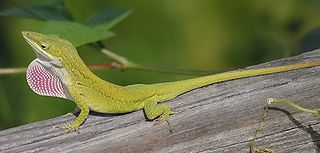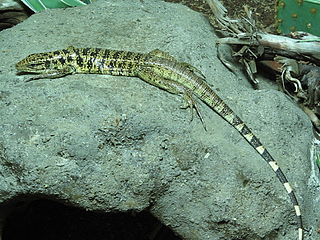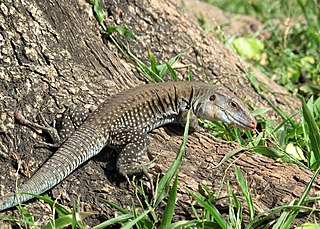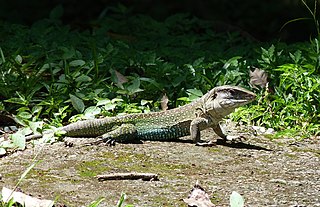
Dactyloidae are a family of lizards commonly known as anoles and native to warmer parts of the Americas, ranging from southeastern United States to Paraguay. Instead of treating it as a family, some authorities prefer to treat it as a subfamily, Dactyloinae, of the family Iguanidae. In the past they were included in the family Polychrotidae together with Polychrus, but the latter genus is not closely related to the true anoles.

Teiidae is a family of autarchoglossan lizards native to the Americas. Members of this family are generally known as whiptails or racerunners; however, tegus also belong to this family. Teiidae is sister to the Gymnopthalmidae, and both families comprise the Teiioidea. The Teiidae includes several parthenogenic species – a mode of clonal reproduction. Presently, the Teiidae consists of approximately 150 species in eighteen genera.

Anolis carolinensis or green anole is a tree-dwelling species of anole lizard native to the southeastern United States and introduced to islands in the Pacific and Caribbean. A small to medium-sized lizard, the green anole is a trunk-crown ecomorph and can change its color to several shades from brown to green.

The six-lined racerunner is a species of lizard native to the United States and Mexico.

The common Puerto Rican ameiva or Puerto Rican ground lizard is a species of lizard in the whiptail family.

The Dominican ground lizard or Dominican ameiva is a species of lizard. It is endemic to the Caribbean island of Dominica, an island noted for its intact and abundant reptile population, where it is most commonly found in dry coastal woodland.
The Sombrero ameiva is a lizard species in the genus Ameiva. It is endemic to Sombrero, a small, uninhabited island in the Lesser Antilles under the jurisdiction of Anguilla.
Censky's ameiva, also known as the Little Scrub Island ground lizard, is a species of lizard in the family Teiidae. It is indigenous to the Caribbean.

Pholidoscelis plei, known commonly as the Anguilla Bank ameiva or the Caribbean ameiva, is a species of lizard in the family Teiidae. The species is found on the Caribbean islands of Anguilla, Saint Martin, and Saint Barthélemy in the Lesser Antilles. Its coloration and markings vary between each island population. Two subspecies are recognized as being valid, including the nominotypical subspecies.
The Montserrat ameiva is a lizard species in the genus Pholidoscelis. It is found on the Caribbean island of Montserrat in the Lesser Antilles.

Anolis luciae, also known commonly as the St. Lucia anole or Saint Lucian anole, is a species of anole lizard in the family Dactyloidae. The species is endemic to Saint Lucia, an island-nation in the Caribbean Lesser Antilles.

The Grenada bush anole or bronze anole is a species of anole lizard found in the Caribbean Lesser Antilles and South America. It is distributed on Grenada and throughout the Grenadines islands, and it has been introduced to Trinidad and Tobago. It can also be found in Guyana on the mainland, where it is locally abundant, though these populations are not native, either.

Ameiva atrigularis, known as giant ameiva and Amazon racerunner, is a species of teiid lizard found on Trinidad and Tobago and in Venezuela. Males can reach a snout–vent length of 186 mm (7.3 in).

Plica plica is a species of lizard in the family Tropiduridae, the Neotropical ground lizards. Its common names include collared tree lizard, collared tree runner,tree runner, and harlequin racerunner. In Guyana it is known as wakanama.

Pholidoscelis wetmorei is a species of lizard in the family Teiidae (whiptails). The species is endemic to Puerto Rico. Its common names include the Puerto Rican blue-tailed ameiva, Wetmore's ameiva, and blue-tailed ground lizard.

Anolis cuvieri is a species of lizard in the family Dactyloidae. The species is endemic to Puerto Rico, and is common in the Toro Negro State Forest.

Ameiva praesignis, known as giant ameiva and Amazon racerunner, is a species of teiid lizard found in Costa Rica, Panama, Venezuela, and Colombia.















